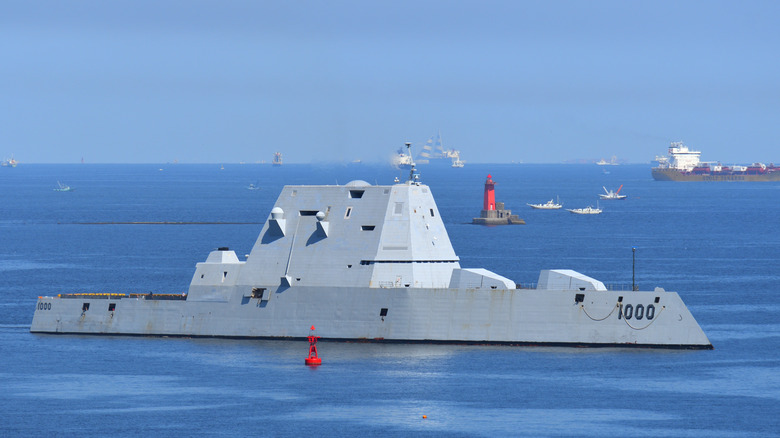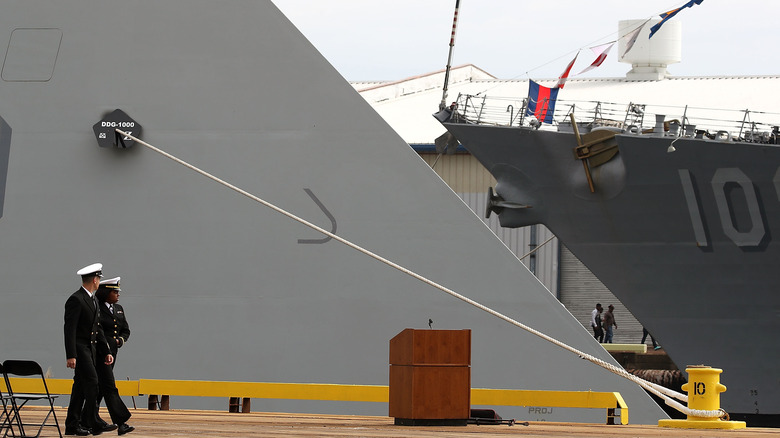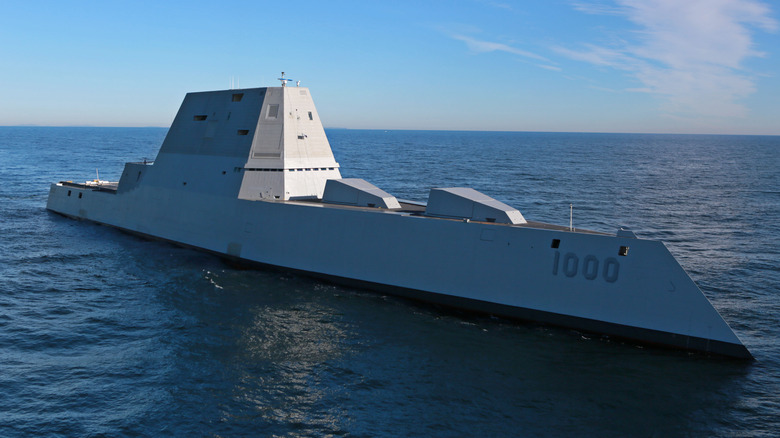This Strange Design Behind This Guided Missile Destroyer Is Actually Genius
With military designs in particular, form and function must typically be emphasized over style. The USS Zumwalt is a prime example of this. It's certainly not the most aesthetically pleasing of ships, boasting sharp and rather harsh lines on top of an overall angular look.
USS Zumwalt was commissioned in October of 2016, and two others have joined the Zumwalt class roster: the USS Michael Monsoor and USS Lyndon B. Johnson. Of course, guided missile destroyers don't really tend to be big on subtlety, but the concept of the Zumwalt class is quite unique, and that was intended to be reflected in its design itself.
The mighty vessels, weighing in at 16,000 tons and costing approximately $4.4 billion in the case of the first ship alone, were intended to be, as far as the fast-moving world of technology allows, future-proof. Fascinatingly, their rather "generic sci-fi" appearance is a huge part of this. Here's how the strange design of the ship was intended to ease its passage through the seas (in more ways than one).
The stealthy contours of the USS Zumwalt
The idea for the mighty Zumwalt, early in development, was to add a line of vessels with long-range support capacity to the roster, able to strike land targets. USNI News noted in August 2023 that Zumwalt began maintenance to be fitted with the in-development Common Hypersonic Glide Bodies (estimated to be completed in 2025). To best fulfill such a role, the Zumwalt destroyers' development emphasized reducing their vulnerability to attack. This is the first important purpose of its highly unconventional design.
As All Hands magazine reports, "the composite superstructure significantly reduces cross section and acoustic output making the ship harder to detect by enemies at sea." As a ship equipped with sophisticated surveillance equipment such as its Multi-Function Radar, this class can derive huge benefits from its powerful yet understated design.
Given its intended role, there can be no more important focus for the Zumwalt than locating unfriendly craft while attempting to evade notice itself, and this is one function that its design serves. There's another key benefit to its design too, though.
Feeling seasick? Not on the Zumwalt
Motion sickness is very common and potentially very debilitating. One-quarter of people are prone to it, and it can make a misery of anything from a short drive to the store to a lengthy voyage on an enormous United States Navy destroyer. With the Zumwalt class, however, this doesn't appear to be as much of an issue. The sharp and rather harsh lines of the ship cut through rough oceans as the destroyer moves forward, and the tumblehome design was also intended to provide a smoother ride as it does so. Popular Mechanics reports that the USS Zumwalt's Captain Carlson considers features like the positioning of the rudders, as well as the hull shape, to be key factors in the destroyer's ability to potentially pitch less in stormy conditions and rougher oceans.
In January 2020, Defense News quoted Captain Carlson as saying, "a storm up near Alaska ... presented us with Sea State Six conditions ... I'd rather be on that ship than any other ship I've been on." Carlson explained that this was because the unusual hull design (wider near the water level) made the movement feel less severe. "As long as you get used to the finer oscillation, it really handles very well," the Captain concluded.
Even the largest ships and the most experienced seafarers are at the mercy of awful conditions at times, so this is another huge boon for the unconventional vessel.


